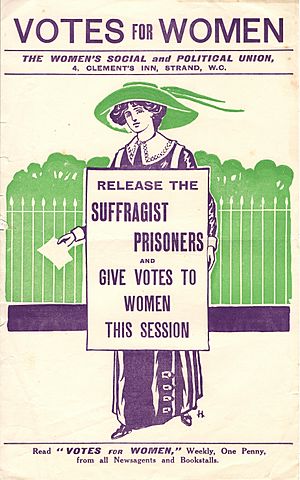Catherine Corbett facts for kids
Quick facts for kids
Catherine Corbett
|
|
|---|---|
| Born |
Catherine Isobel Ida Vans Agnew
1869 |
| Died | 1950 Surrey, England, UK
|
| Organization | Women's Social and Political Union |
| Known for | suffragette hunger striker |
| Honours | Hunger Strike Medal for Valour |
Catherine Corbett (born Vans Agnew; 1869–1950) was a brave British woman. She was a suffragette who fought for women's right to vote. She was even sent to prison for her beliefs. Catherine received a special medal for her courage. This was the Hunger Strike Medal. She worked with the Women's Social and Political Union.
Contents
Who Was Catherine Corbett?
Catherine Isobel Ida Vans Agnew was born in 1869. Her parents were George Vans Agnew and Rosa Coppard Wilson. She had four brothers and one sister. People called her Catherine or Ida.
She married Frank Corbett in 1895. Sadly, her husband passed away in 1912. Catherine was known as a tall and striking lady.
Fighting for Votes for Women
Catherine became very active in the WSPU. This group worked hard to get women the right to vote. They were often called suffragettes.
In 1908, Catherine was arrested for protesting. She was photographed with other suffragettes. She spent four weeks in prison. A newspaper even called her an "aristocrat supporter" of the movement.
Catherine and other women tried to meet the Prime Minister, H. H. Asquith. They wanted to talk about women's voting rights. The Prime Minister told them, "I think you are very silly." The Museum of London has a photo of these women walking with him.
Protesting in Dundee
Later in 1908, Catherine went to Dundee, Scotland. She joined other suffragettes like Adela Pankhurst and Helen Archdale. They planned to protest a meeting held by Winston Churchill. He was a Member of Parliament (MP) at the time.
Catherine and Helen Archdale bravely jumped off a tram. They gathered local people to help them. They rushed towards the building where Churchill was speaking. They waved the WSPU colors and shouted "Votes for Women!"
The protest turned into a big event. It lasted for three hours. Police on horses arrived. They used batons to clear the crowd. The protestors were locked in the basement. Catherine said the protestors were "glorious" and very brave. Churchill, however, called them "silly, neurotic, hysterical women."
Catherine and the other women were arrested and sent to prison. They decided to go on a hunger strike.
Hunger Strike and Release
When Catherine and the others were in prison in Dundee, they refused to eat. This was a hunger strike. It was a way to protest their imprisonment.
The prison governor decided not to force-feed them. This was different from other prisons in England. He worried about their health. He also knew that local people supported the women.
When Catherine and the others were set free, they were met by other suffragettes. These brave women were waiting at the prison gate.
Catherine Corbett's name is listed in a special "Role of Honour." This list remembers suffragette prisoners. She also received the Hunger Strike Medal for her courage.
Later Life
Catherine Corbett passed away in Surrey, England, in 1950.


